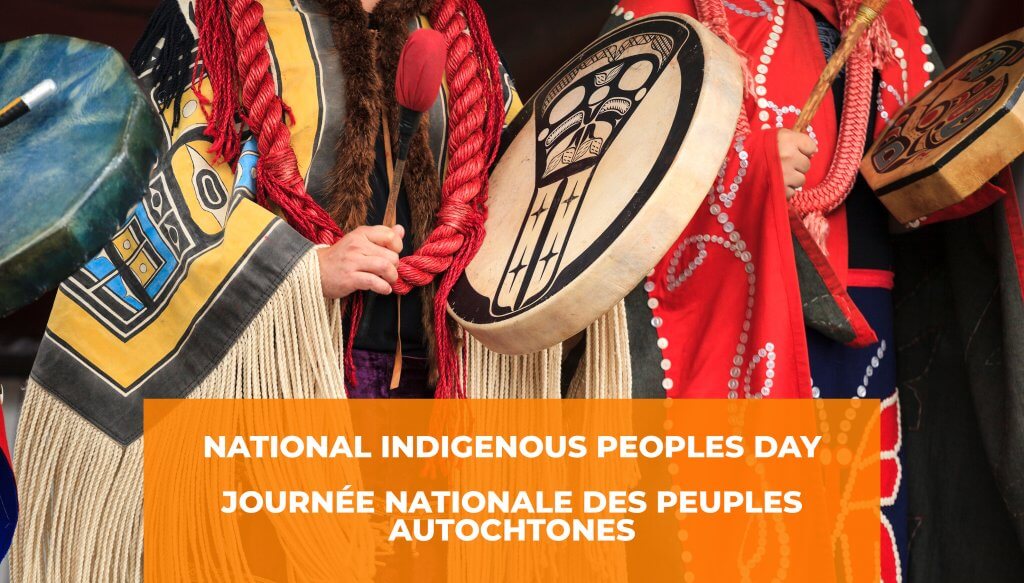National Indigenous Peoples Day
June 21st is National Indigenous Peoples Day. This is a day for all Canadians to recognize and celebrate the unique heritage, diverse cultures and outstanding contributions of First Nations, Inuit and Métis peoples. In cooperation with Indigenous organizations, the Government of Canada chose June 21, the summer solstice as National Indigenous Peoples Day. For generations, many Indigenous peoples and communities have celebrated their culture and heritage on or near this day due to the significance of the summer solstice as the longest day of the year.[1]
Announced by proclamation in June 1996 by then Governor General of Canada, Romeo LeBlanc, this day was the result of consultations and statements of support for such a day made by various Indigenous groups:
- In 1982, the National Indian Brotherhood (now the Assembly of First Nations) called for the creation of National Aboriginal Solidarity Day
- In 1995, the Sacred Assembly, a national conference of Indigenous and non-Indigenous people chaired by Elijah Harper, called for a national holiday to celebrate the contributions of Indigenous Peoples
- Also in 1995, the Royal Commission on Aboriginal Peoples recommended the designation of a National First Peoples Day[2]
As the longest day of the year, the summer solstice has held a deep cultural, historical, and spiritual significance for many Indigenous peoples and communities for generations. It was just over 25 years ago that the Government of Canada joined Indigenous organizations in choosing June 21 to celebrate National Indigenous Peoples Day. [4]
We must also acknowledge, honor, and respect those who have passed. Our goal is to encourage members to learn about and reflect on our country’s history and present-day truths, as well as to commemorate the survivors, their families, and their communities-as called for by the Truth and Reconciliation Commission and Indigenous leaders. [6]
On June 21, 2021 the Government of Canada announced that they would pass legislation to advance the implementations of the United Nations Declarations on the Rights of Indigenous Peoples. Indigenous leaders, the Truth and Reconciliation Commission, and the National Inquiry into Missing and Murdered Indigenous Women and Girls have all said that the Declaration is a roadmap for the federal government to work in partnership with Indigenous peoples to advance reconciliation.[7]
One year ago today, the United Nations Declaration on the Rights of Indigenous Peoples Act received Royal Assent and immediately came into force. This legislation advances the implementation of the Declaration as a key step in renewing the Government of Canada’s relationship with Indigenous peoples.
United Nations Declaration on the Rights of Indigenous Peoples Act
It is our responsibility to make significant change within ourselves and continue to support our members by lobbing governments to review, rebuild or develop laws and policies to improve outcomes for Indigenous peoples and for all Canadians. And to continue to ensure improvements and implementation of the United Nations Declarations on the Rights of Indigenous Peoples.[8]
[1] https://www.rcaanc-cirnac.gc.ca/eng/1100100013718/1534874583157
[2] https://www.thecanadianencyclopedia.ca/en/article/national-aboriginal-day#:~:text=In%201982%2C%20the%20National%20Indian,day%20to%20celebrate%20Indigenous%20culture.
[4] https://www.rcaanc-cirnac.gc.ca/eng/1100100013718/1534874583157
[6] https://www.canada.ca/en/canadian-heritage/campaigns/national-day-truth-reconciliation.html
[7] https://www.canada.ca/en/department-justice/news/2021/06/legislation-to-implement-the-united-nations-declaration-on-the-rights-of-indigenous-peoples-becomes-law.html
